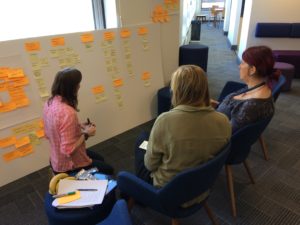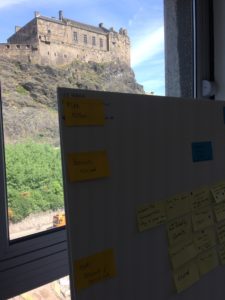Working in the open
We run a lot of workshops and facilitate a lot of design thinking activities.
Sometimes we struggle for meeting rooms when running something at short notice but actually, I enjoy working in impromptu and open spaces. Here’s why…
One of the best things about working with Information Services, and our relocation to Argyle House, has been the availability of new facilities that comes when 800+ staff all come together in a purpose-built space. We’ve got a great suite of meeting and training rooms but they’re heavily in demand. Getting a space at short notice can be challenging sometimes.
Getting a room suitable for a workshop of more than 6 people for more than an hour or two can take weeks to schedule. That’s not ideal, especially when demand for our services is growing rapidly and requests for quick help are becoming more frequent as colleagues learn what we can do.
Adapting to new spaces
But do we really need a meeting room every time? Not necessarily.
I recently invested in large foam boards so that we can take our walls with us. (They don’t fit in the lifts which makes for some interesting journeys through the stairwell but it’s all do-able with a bit of help on the doors!)
These boards give us a great deal of flexibility and I’ve been taking advantage of this in recent months to stage workshops in other locations. Our staff social space is well established as a place for impromptu and informal meetings so I’ve been taking the next logical step and running short mini-workshops there. We’ve also tried out sessions in the spaces between banks of desks on some of our open office spaces.
Why work in the open?
That’s a fair question – we’re quite exposed and potentially could be disruptive to people just trying to eat their lunch or have a break.
But I’m finding – just as I’d hoped – that if we work in the open and we leave our work-in-progress boards in public spaces, people notice what we’re doing.
They’re curious.
They’re interested in how we’re working together.
They spot things that relate to their work and their challenges.
They ask questions.
And that’s exactly what we need if we are to embed new ways of working across teams and disciplines: approaching problem solving in new ways.
The future
People talk about digital transformation and how it’s disrupting business models and services. But it should also be disrupting how we work together. We don’t achieve new digital services – shaped around the user, delivering value and exceeding their expectations – by continuing to work the way we’ve always worked.
If we do, we’re just delivering more IT projects like we’ve done for the past 10 or 20 years. And we’ll get the same results.
New ways of working require new working spaces. And hopefully I’m demonstrating this in accessible ways that encourage colleagues to explore with us.
Recent examples of us working in the open
In this session I changed our planned meeting at short notice, and the team I was working for pulled together a small group to brainstorm and classify target audience groups. We brought in new perspectives and achieved greater consensus on who we were serving in under an hour.
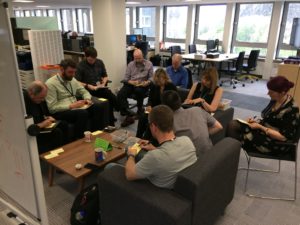
We ran an impromptu workshop instead of a meeting in a small collaboration space between colleagues’ desks.
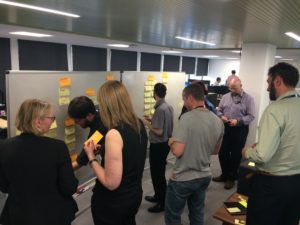
We used whiteboards and foam boards to cordon off a space and (hopefully) minimise disruption for colleagues working at nearby desks
This session followed on from the one above. By this point one of our consultants, Nicola, had picked up the project and was working with service managers to make sense of their existing knowledge and map assumptions. Working in our staff social area made the whole exercise more relaxed and the group worked together through most of the day, taking breaks around their work-in-progress.
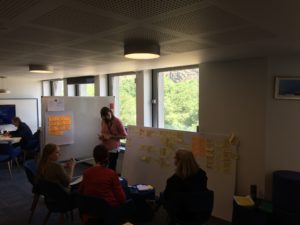
Nicola’s session helped service managers to make sense of what they already knew about their customer base.
In this session, I ran a more formally organised mapping exercise. Because of staff and room availability, I cornered off a portion of our staff social area to give us a little privacy while we worked. Once the 2 hour session was wrapping up in the lead in to the busiest period of the day over lunch, I was able to invite interested colleagues to take a look at what we’d been doing while they waited for the microwave to ping.

I took over a corner of our staff dining area for a couple of hours to bring together a busy group of project stakeholders together at short notice. (Kitchen just behind participants on the right)
Related reading
Why we workshop – blog post
Learn more about design thinking with Lynda.com
Read case studies of our recent work helping services become more user-focused


